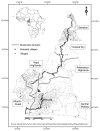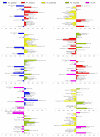Habitat suitability and ecological niche profile of major malaria vectors in Cameroon
- PMID: 20028559
- PMCID: PMC2805691
- DOI: 10.1186/1475-2875-8-307
Habitat suitability and ecological niche profile of major malaria vectors in Cameroon
Abstract
Background: Suitability of environmental conditions determines a species distribution in space and time. Understanding and modelling the ecological niche of mosquito disease vectors can, therefore, be a powerful predictor of the risk of exposure to the pathogens they transmit. In Africa, five anophelines are responsible for over 95% of total malaria transmission. However, detailed knowledge of the geographic distribution and ecological requirements of these species is to date still inadequate.
Methods: Indoor-resting mosquitoes were sampled from 386 villages covering the full range of ecological settings available in Cameroon, Central Africa. Using a predictive species distribution modeling approach based only on presence records, habitat suitability maps were constructed for the five major malaria vectors Anopheles gambiae, Anopheles funestus, Anopheles arabiensis, Anopheles nili and Anopheles moucheti. The influence of 17 climatic, topographic, and land use variables on mosquito geographic distribution was assessed by multivariate regression and ordination techniques.
Results: Twenty-four anopheline species were collected, of which 17 are known to transmit malaria in Africa. Ecological Niche Factor Analysis, Habitat Suitability modeling and Canonical Correspondence Analysis revealed marked differences among the five major malaria vector species, both in terms of ecological requirements and niche breadth. Eco-geographical variables (EGVs) related to human activity had the highest impact on habitat suitability for the five major malaria vectors, with areas of low population density being of marginal or unsuitable habitat quality. Sunlight exposure, rainfall, evapo-transpiration, relative humidity, and wind speed were among the most discriminative EGVs separating "forest" from "savanna" species.
Conclusions: The distribution of major malaria vectors in Cameroon is strongly affected by the impact of humans on the environment, with variables related to proximity to human settings being among the best predictors of habitat suitability. The ecologically more tolerant species An. gambiae and An. funestus were recorded in a wide range of eco-climatic settings. The other three major vectors, An. arabiensis, An. moucheti, and An. nili, were more specialized. Ecological niche and species distribution modelling should help improve malaria vector control interventions by targeting places and times where the impact on vector populations and disease transmission can be optimized.
Figures




References
-
- Brown JH, Mehlman DW, Stevens GC. Spatial variation in abundance. Ecology. 1995;76:2028–2043. doi: 10.2307/1941678. - DOI
-
- Hutchinson GE. Concluding remarks. Harbour Symposium on Quantitative Biology. 1957. pp. 415–427.
-
- Hirzel AH, Hausser J, Chessel D, Perrin N. Ecological-niche factor analysis: How to compute habitat- suitability maps without absence data? Ecology. 2002;83:2027–2036.
-
- Hirzel AH, Le Lay G, Helfer V, Randin C, Guisan A. Evaluating the ability of habitat suitability models to predict species presences. Ecol Model. 2006;199:142–152. doi: 10.1016/j.ecolmodel.2006.05.017. - DOI
Publication types
MeSH terms
Grants and funding
LinkOut - more resources
Full Text Sources
Medical

